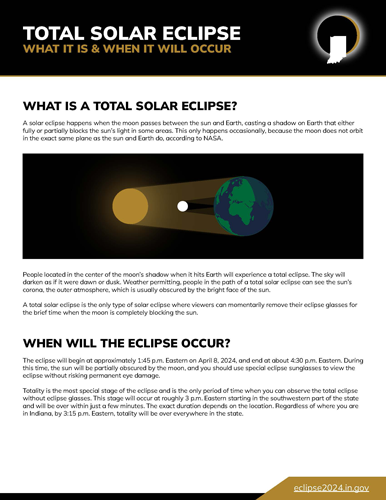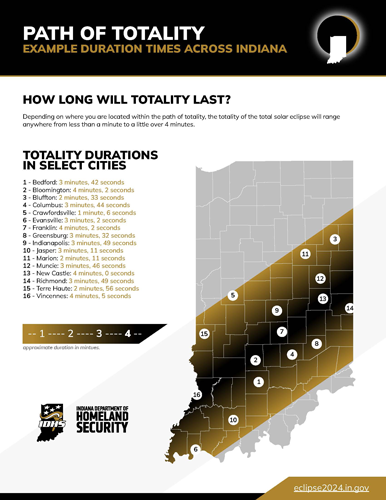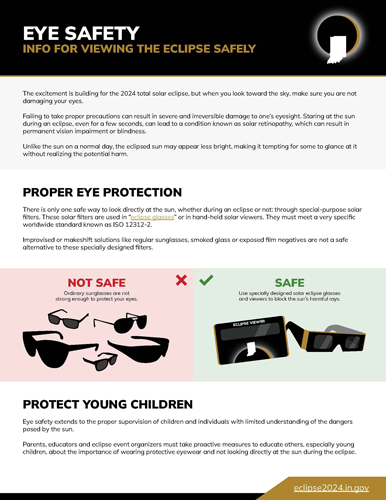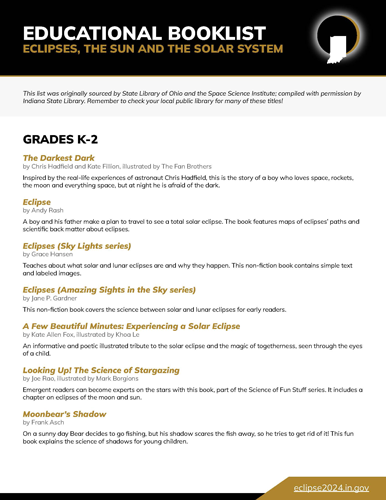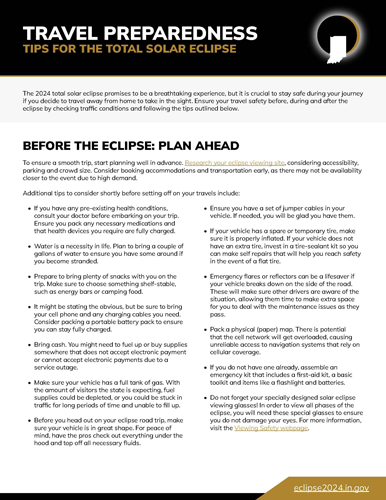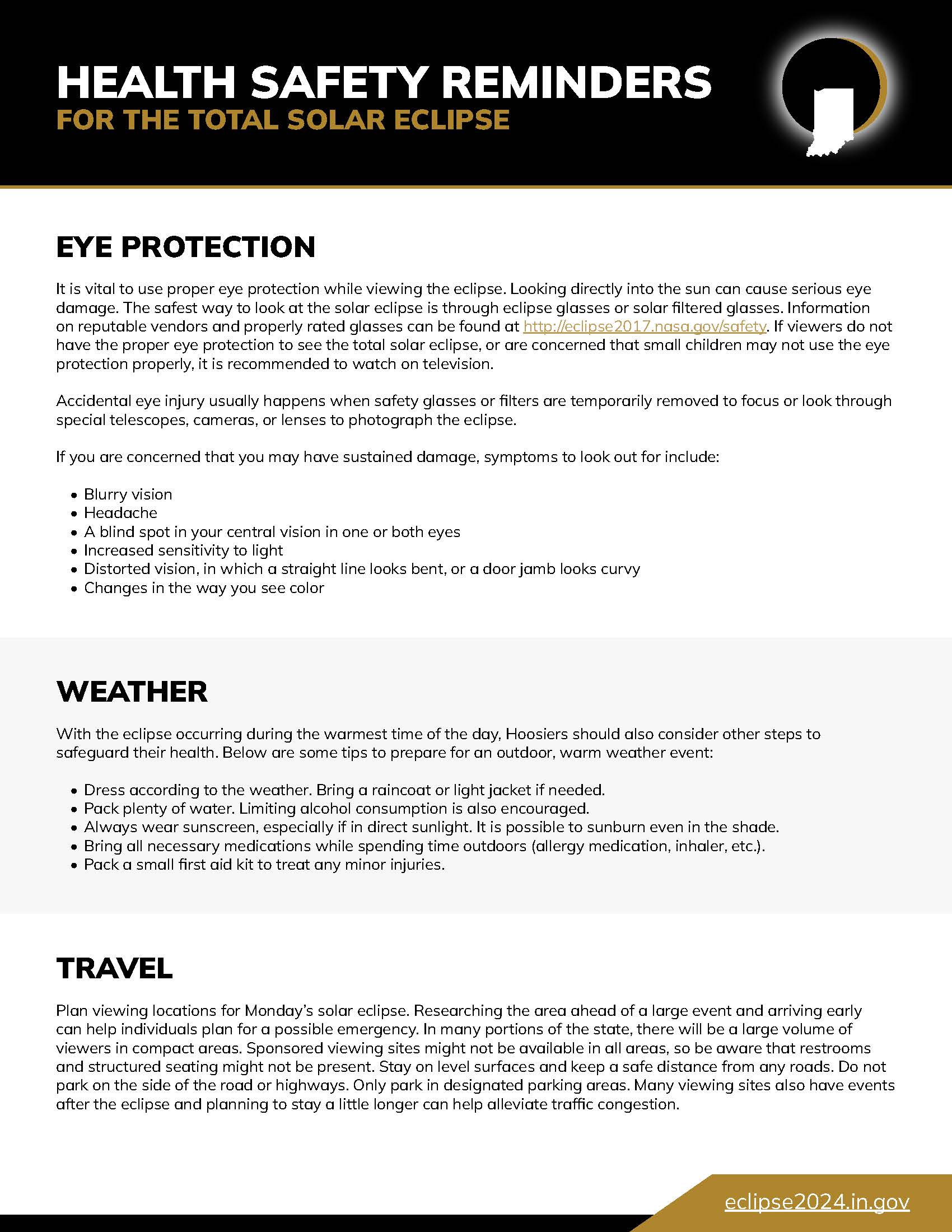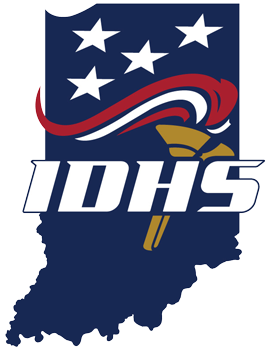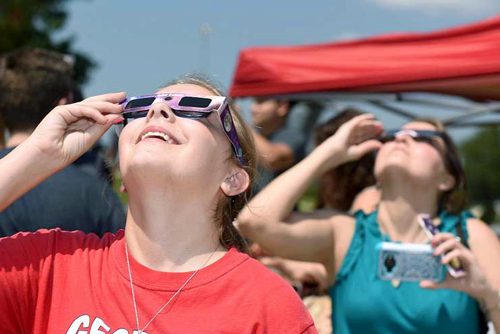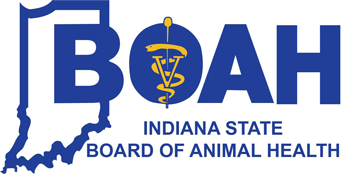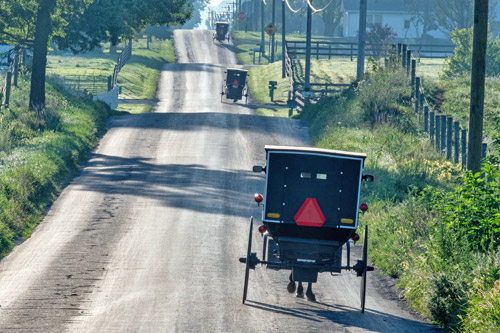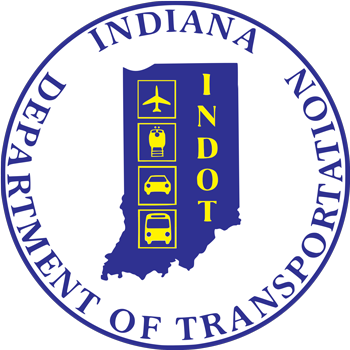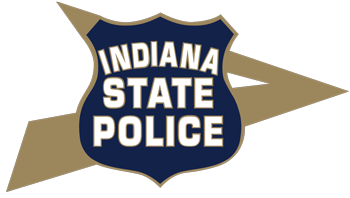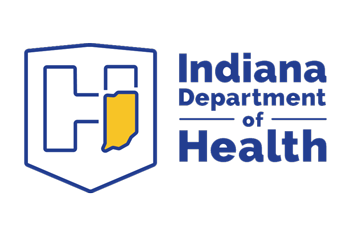Jump to
Jump to
First Responder Planning
First responders will be extremely active during the eclipse, which is expected to bring common headaches that are associated with large gatherings, like the crowd the eclipse will bring to Indiana. Traffic congestion, potential accidents, health and safety risks and more are all part of the planning process for IDHS and partner agencies such as DNR, INDOT, ISP and others. For the past year, a large group of state and local agencies have been meeting to plan for the unique total solar eclipse event in Indiana. The state expects several hundred thousand additional people in Indiana on April 8, 2024, and it certainly is expected to be an “all-hands-on-deck” event.
Much of the activities required to respond will be coordinated through the State Emergency Operations Center with support from emergency response teams and subject matter experts positioned strategically around the state.
But the uniqueness of a total solar eclipse in Indiana requires training and coordination like no other event typical to the state. Also, the eclipse is not confined to a specific location, which will leave rolling incidents of various sizes taking place throughout the path of totality.
Simple things like the availability of nearby ambulances, tow trucks for traffic-snarled areas or injured campers in open fields, and even toilet facilities create unknown scenarios. Think about if blackout occurred in Indianapolis, but multiply that by the dozen or so counties that will be in the dark for more than 4 minutes. Said another way, public safety officials will be asked to manage a crowd five times the size of the Indianapolis 500 race and across a broad section of the state.
It is estimated that 43 million people live in the path of totality for the 2024 total solar eclipse, not counting those who will travel to experience the event.
- Priorities for First Responders
- Address life safety needs.
- Support local governments and resource requests.
- Support safe movement along Indiana’s transportation system.
- Ensure coordination and communication among local, state and federal officials.
“We started meeting more than year out from the event because of the importance of forming these working relationships and sharing information with our partners,” said Mary Moran, director of the IDHS Emergency Management and Preparedness Division. “By working together, we can overcome any of the challenges this event may cause. If we overprepare, that is not such a bad thing for Hoosiers.”
Traffic, and the safety concerns that come with congestion, are the top priorities for planning. For the total solar eclipse in 2017, most people who traveled to view the eclipse departed for home within two hours of the viewing. The roads typically are congested within 15 minutes, experts say.
Traffic may become gridlocked on highways across the state leading up to the eclipse and immediately after totality, and so drivers may seek alternate routes on county roads and local streets that typically would not see much traffic. There may be extreme demand on local resources, such as gas stations, which may lead to acute fuel shortages. Drivers who are unable to refill their tanks may run out of gas in traffic or alongside roadways.
With traffic peaking after totality around 3 p.m. Eastern, departments should consider whether staffing shift changes should occur earlier in the day, as well as whether response vehicles should be located strategically to anticipate gridlock on both main roads and local streets.
Additional Factors
- Recreational drug use may increase, so there may be a higher incidence of overdose cases to tend to.
- If there are local or nearby festivals or events, there may be issues common to mass gatherings, such as crowd control and altercations.
- Extreme traffic congestion may lead to road rage incidents.
- Travelers may become lost, and some visitors may become separated from their families.
- Vehicles may park in unusual and remote places, including soft or wet ground and fields. If people experience medical emergencies in these areas, consider how to get access to places that may be off-road or inaccessible to standard response vehicles. Also consider what equipment may be needed to help someone who is located in a difficult-to-reach location.
- Communications systems may experience disruptions due to high data and communication network use. Ensure that public safety radios are set up properly, pre-programmed and ready to use. Prepare the radios now and contact the Integrated Public Safety Commission for assistance if needed.
- Traffic Considerations for First Responders
- What is being done locally? Are there traffic management plans? Is your department involved in the planning process?
- Are there events in nearby cities and towns, and how will their traffic management plans affect your operations?
- How and when will first responders themselves get to work if traffic loads are heavy throughout the day?
- Should there be satellite parking areas with shuttles?
- Long-distance travelers need information (social media).
- Coordination between jurisdictions is key.
- Safety Messaging for Drivers
- Fill up your gas tank before traveling.
- Do not stop along the interstate or shoulder.
- Exit the highway to view or photograph the event.
- Do not take pictures while driving.
- Turn on headlights.
- Watch for pedestrians.
- Expect congestion the day before, the day of and the day after the eclipse (come early; stay late).
- Guidance for EMS Organizations
As EMS organizations finalize their preparedness plans for the eclipse, IDHS has produced a guidance document to remind and assist them.
- Downloadable Resources
Emergency Management Planning
The eclipse brings a unique opportunity for emergency management agencies and community leaders to welcome thousands of people to their counties, cities and towns. As awesome as this sight will be, the safety and well-being of Hoosiers and visitors will remain paramount. By exploring the resources provided here, emergency managers and leaders can contribute to a well-prepared and thriving community during the celestial event.
- General Information
The next total solar eclipse in Indiana will not be until 2099. This is an extremely rare event, and viewers will be treating it as such. State agencies have been contacted already from people in Europe and South America.
Traffic will be a major concern. Encourage visitors to stay in place after the eclipse to avoid severe traffic jams.
- Emergency Management Tools
- Eclipse Location and Duration Times
- Total Solar Eclipse (TSE) Exercise in a Box
- Instructions for TSE Exercise in a Box
- TSE Exercise in a Box
- TSE Exercise in a Box Presentation Template
Note: The presentation file was researched and compiled by IDHS. Editable sections are highlighted in yellow. Please avoid editing other information. If you have any questions, ask the IDHS Exercise Section at exercise@idhs.in.gov.
- Integrated Public Safety Commission: Eclipse Communication Planning Guide
- Rumor Control Guidance
- Safety and Preparedness
Eye Safety
Eye safety will be critical. Encourage your communities to buy eclipse glasses from verified vendors.
- How To Tell If Eclipse Glasses or Handheld Solar Viewers Are Safe
- Reputable Sources for Eclipse Viewing Products
- Eclipse Glasses (Indiana Department of Natural Resources)
- Indiana Department of Health Resources
Resource Allocation
Emergency managers should consider how can resources be effectively allocated to ensure public safety during eclipse-related activities, including traffic management and emergency response.
- Are there adequate resources, including personnel and equipment, available for emergency response during the eclipse?
- Consider setting up an incident management team (IMT) for this event and creating an incident action plan now.
Traffic
The eclipse will take only about eight minutes to move throughout Indiana. Then viewers will be trying to travel home or out of the state. It will not take long for interstates to become gridlocked. People taking detours will cause backroads to become gridlocked as well. Start looking now at how to mitigate those problems.
- Start looking at nonconventional ways to conduct traffic and to get emergency response personnel to places they may need to go after the event.
- Events like festivals or concerts could encourage visitors to stay later.
DNR and INDOT are working to commit message boards for state parks and traffic management. INDOT will not have any maintenance ongoing this day but may use crews to have a one-day Hoosier Helper program to carry gas and other small resources in local communities.
- Submit a list of potential choke points to INDOT.
- Share INDOT and Indiana State Police traffic guidance
Lodging
Many hotels are sold out and a majority of sites and campgrounds on DNR properties have been booked.
- Be aware of people trying to find last-minute hotels.
- Recognize the potential for trespassing.
- Be prepared for people crowding in non-ideal places.
Public Facilities
- Do counties, cities or towns have enough public facilities, such as restrooms and parking areas, to accommodate the increased number of visitors?
Adverse Weather
Have a contingency plan to react to the weather conditions on April 8 (cloudy, storms, snow, ice, etc.).
Schools
Community leaders and emergency managers need to have conversations with schools to determine best practices. School buses may be caught in eclipse traffic when taking students home.
- How do schools take care of students stuck in traffic?
- Should school close that day or release early to avoid traffic?
- State Emergency Operations Center Expectations
The State Emergency Operations Center (SEOC) is treating the eclipse as a special event. It will be staffed Saturday, April 6, through Tuesday, April 9.
- No mission requests will be taken in advance.
- Expect gaps in fuel and EMS runs.
- Expect time delays for all emergency responders.
- State agencies need to look at mutual aid.
- IDHS will be using resource catalog to track, but missions will only be reviewed on a case-by-case basis the day of.
- Resources
Emergency managers have specialized training in event management, although a total solar eclipse — a rare event — presents unique challenges.
The Domestic Preparedness training website offers these tips for emergency managers when planning for the total solar eclipse:
- Focus on local surge capacity.
- Understand mutual aid channels.
- Get involved in partner planning/task forces.
- Identify preferred viewing locations.
- Secure the necessary resources for maximum capacity at viewing locations.
- Map ingress and egress.
Purdue University created a community planning resources webpage that includes information about microgrants that can elevate events that are eclipsed-focused. Grant information is under the Funding Resources section.
Additional Resources
- Contact Information: County Emergency Managers and Regional IDHS Staff
- Dr. Kate Russo: A Guide for Communities in the Path of Totality
- GreatAmericanEclipse.com
- NASA Eclipse Website
- NASA Night Sky Network
- National Operations Center of Excellence
State Agency Eclipse Websites
State Public Safety Planning and Guidance
As the state gears up April 2024, many state agencies are meeting and coordinating efforts to ensure that Hoosiers and out-of-state travelers alike can enjoy the eclipse safely. Select an agency to learn what it is doing for the eclipse or its guidance for the public.

